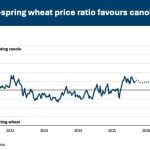This year’s annual announcement of the railway’s revenue cap results didn’t have the drama or shock value of a year ago.
And that’s fine as far as Lanette Kuchenski is concerned.
“This is a lot more normal and a lot less stressful,” the executive director of the Western Grains Research Foundation said.
The Canadian Transportation Agency announced Dec. 31 that Canadian National Railway exceeded its 2008-09 grain revenue cap by $683,269. As a result, the railway will have to pay that amount plus a five percent penalty to the WGRF for a total of $717,432.
Read Also

Farmers urged to be grain-safe this fall
Working around grain bins comes with risk, from farmers falling to drowning in grain: Experts have five tips to help avoid grain-related accidents this harvest.
The money will go into the foundation’s endowment fund, with interest earnings used to fund grain industry research.
CN spokesperson Kelli Svendsen noted the overage represented one percent of the railway’s revenue cap entitlement.
“We’re reviewing the agency’s calculation but it’s too soon to address whether there will be any legal challenge,” she said.
CN has until the end of February to make that decision. The Federal Court of Appeal is currently considering a CN challenge arising from the 2007-08 CTA calculation.
The agency also announced that Canadian Pacific Railway’s revenue was $1,149,665 below its cap and will not be required to make a payment.
CPR spokesperson Breanne Feigel said the railway plans to end the year as close to its revenue cap as possible and is pleased with this year’s outcome.
The 2008-09 cap results are in line with the first seven years the cap was in effect, during which time the rail companies exceeded their maximum allowable revenues by a total of just $8.9 million.
That all changed last year, after the agency ordered the railways to pay $68.7 million (including penalties) to the WGRF after determining the rail companies had been overpaid for hopper car maintenance for a number of years.
That triggered a series of legal challenges and put the WGRF in the middle of a public and political controversy.
The result was a debate over whether that money should go to the WGRF to fund crop research or be directed to individual farmers who had been overcharged.
As things developed, no changes were made and the foundation now has more than $80 million in its endowment fund, which will enable it to pay out annual interest earnings of some $4.5 million in research funding.
Kuchenski said the WGRF is engaged in a planning process to determine the best way to handle its newfound source of research funding.
The application process for research projects begins later this month and runs until April 1 and the foundation’s board of directors is expecting requests from researchers.
“The nice thing is we will have a lot more funds available to fund research into all crop types,” said Kuchenski.
The total combined revenue cap entitlement for the two railways increased by $208 million in 2008-09, reflecting increased grain volumes and an eight percent rise in the railways’ inflation-related costs, mainly fuel and labour.














